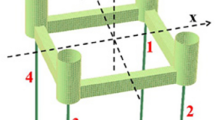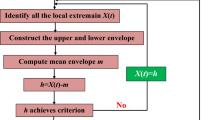Abstract
The key concept of spectrum response estimation with commercial software, such as the SESAM software tool, typically includes two main steps: finding a suitable loading spectrum and computing the response amplitude operators (RAOs) subjected to a frequency-specified wave component. In this paper, we propose a nontraditional spectrum response estimation method that uses a numerical representation of the retardation functions. Based on estimated added mass and damping matrices of the structure, we decompose and replace the convolution terms with a series of poles and corresponding residues in the Laplace domain. Then, we estimate the power density corresponding to each frequency component using the improved periodogram method. The advantage of this approach is that the frequency-dependent motion equations in the time domain can be transformed into the Laplace domain without requiring Laplace-domain expressions for the added mass and damping. To validate the proposed method, we use a numerical semi-submerged pontoon from the SESAM. The numerical results show that the responses of the proposed method match well with those obtained from the traditional method. Furthermore, the estimated spectrum also matches well, which indicates its potential application to deep-water floating structures.
Similar content being viewed by others
References
Ahmet, A., and Yilmaz, A. S., 2007. Frequency domain analysis of power system transients using Welch and Yule-Walker AR methods. Energy Conversion and Management, 48 (7): 2129–2135.
Clough, R. W., and Penzien, J., 1993. Dynamics of Structures. 2nd editon, McGraw-Hill, New York, 325–341.
Craig, R. R., and Kurdila, A. J., 2006. Fundamentals of Structural Dynamics. 2nd editon, Wiley, Hoboken, NJ, 148–183.
Cummins, W. E., 1962. The impulse response function and ship motions. Schiffstechnik, 9: 101–109.
Hu, S. L. J., Liu, F. S., Gao, B., and Li, H. J., 2016. Pole-residue method for numerical dynamic analysis. Journal of Engineering Mechanics, 142 (8): 04016045.
Jonkman, J. M., and Sclavounos, P. D., 2006. Development of fully coupled aeroelastic and hydrodynamic models for offshore wind turbines. In: 2006 ASME Wind Energy Symposium. Reno, Nevada, CP-500-39066.
Kreyszig, E., 1999. Advanced Engineering Mathematics. 8th edition, John Wiley & Sons, Inc., New York, USA, 203–249.
Liu, F. S., Chen, J. F., and Qin, H. D., 2017. Frequency response estimation of floating structures by representation of retardation functions with complex exponentials. Marine Structures, 54: 144–166.
Liu, F. S., Li, H. J., and Wang, W. Y., 2015. Initial-condition consideration by transferring and loading reconstruction for the dynamic analysis of linear structures in the frequency domain. Journal of Sound Vibration, 336: 164–178.
Liu, F. S., Lu, H. C., and Li, H. J., 2016. Dynamic analysis of offshore structures with non-zero initial conditions in the frequency domain. Journal of Sound Vibration, 366: 309–324.
Newman, J., 1977. Marine Hydrodynamics. MIT Press, Cambridge, MA, 237–327.
Ogilvie, T. F., 1964. Recent progress towards the understanding and prediction of ship motions. Sixth Symposium on Naval Hydrodynamics, 3: 79.
Oppenheim, A. V., Schafer, R. W., and Buck, J. R., 1999. Discrete-Time Signal Processing. Prentice-Hall, Inc., New Jersey, USA, 694–718.
SESAM user manual, 2005. DeepC theory. Det Norske Veritas, Norway, 5–12.
SESAM user manual, 2008. Concept design and analysis of offshore & maritime structures. Det Norske Veritas, Norway, 163–172.
Tick, L. J., 1959. Differential equations with frequency-dependent coefficients. Journal of Ship Research, 3 (2): 45–46.
Acknowledgements
The authors acknowledge the financial support of the National Natural Science Foundation of China (Nos. 5152 2906, 51479184, 51609219), the Excellent Youth Foundation of Shandong Scientific Committee (No. JQ201512), and the Taishan Scholars Program of Shandong Province.
Author information
Authors and Affiliations
Corresponding author
Rights and permissions
About this article
Cite this article
Liu, F., Liu, C., Chen, J. et al. Spectrum response estimation for deep-water floating platforms via retardation function representation. J. Ocean Univ. China 16, 609–616 (2017). https://doi.org/10.1007/s11802-017-3326-4
Received:
Revised:
Accepted:
Published:
Issue Date:
DOI: https://doi.org/10.1007/s11802-017-3326-4




